These Photos Provided By NASA Will Show You How Real Climate Change Indeed Is
Our Earth is undergoing radical change with regards to the climate. The ice caps are melting, hurricanes and storms are getting harsher and harsher, a couple of locations are experiencing greater flooding, wildfires are turning into much more common occurrences, extreme droughts are eliminating entire water sources- the list just goes on and on. Today, a lot of organizations and institutions are keeping an eye on what’s going on on our planet climate-wise, and NASA is one of the most important ones out there. Throughout the years, NASA has been watching more than thousands of locations around the world using its space tech, searching for signs of climate change. Because of these reasons, they launched the website called the Images Of Change where they show the comparison photos of various places on Earth, focusing on melting glaciers, results of wildfires, deforestation, extreme droughts, and a couple of other phenomena.
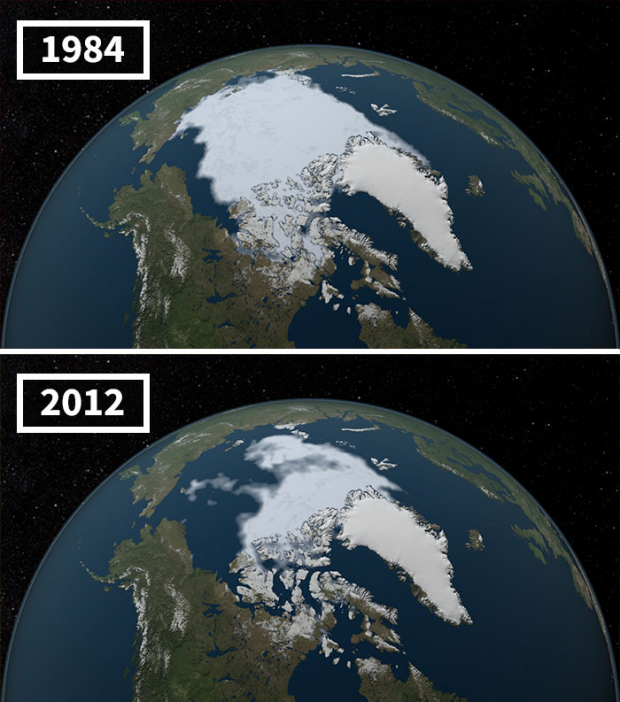
This is what happened to the Arctic Sea ice coverage in a bit more than two decades.
“The part of the Arctic Ocean covered in ice increases during the winter and then shrinks during the summer, typically reaching the year’s low point in September. The minimum coverage for 2012 set a record low since around 1979 when the first dependable satellite measurements began. These photos compare the 1984 minimum, which was approximately equal to the average minimum extent for 1979-2000, with that of 2012, when the minimum was roughly half of that. The 2013 minimum was bigger, however, continued the long-term downward trend of approximately 12 percent sea-ice loss every decade since the late 1970s, a decline that sped up after 2007. The 2016 minimum was named the second-lowest on record. “At the rate we’re noticing this decline,” said NASA scientist Joey Comiso, “it’s highly likely that the Arctic’s summer sea ice will entirely vanish within this century.”
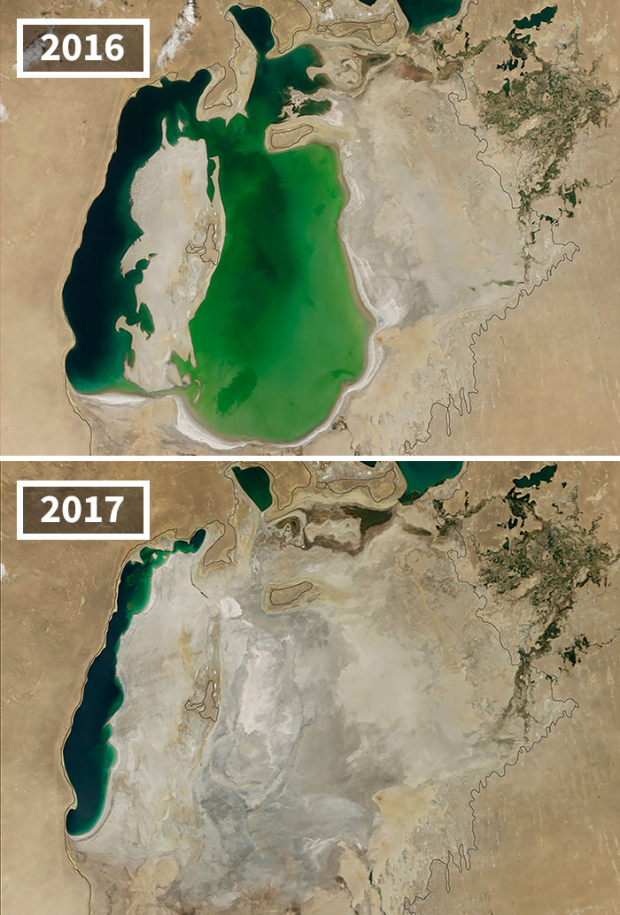
The Aral Sea in Central Asia is rapidly shrinking
“The Aral Sea was the fourth biggest lake on our planet until the 1960s, when the Soviet Union diverted water from the rivers that fed the lake so cotton and other crops could be grown in the dry lands of Kazakhstan, Uzbekistan, and Turkmenistan. The black outline demonstrates the estimated coastline of the lake in 1960. By the time of the 2000 picture, the Northern Aral Sea had separated from the Southern Aral Sea, which itself had divided into eastern and western sections. A dam built in 2005 helped the northern sea recover much of its water, but it sacrificed the southern sea. Dry conditions in 2014 gave rise to the southern sea’s eastern section to dry up entirely for the first time in modern times. The loss of the moderating effect of such a huge body of water has made the region’s winters colder and summers hotter and drier.”
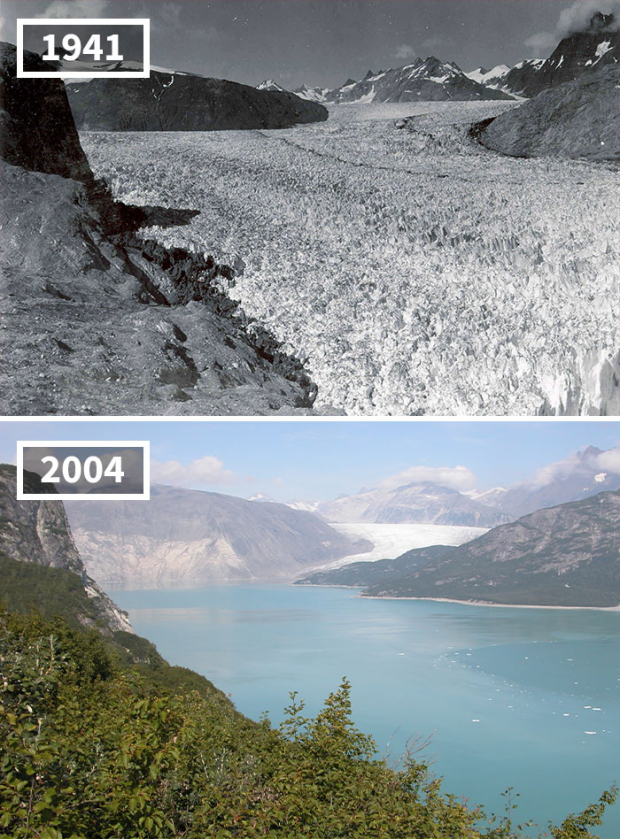
Muir Glacier in Alaska melted entirely
In the 1941 photograph, you can see the lower reaches of Muir Glacier and its tributary, Riggs Glacier. These two glaciers filled Muir Inlet. When it comes to the 2004 photograph, you can see Muir Glacier continuing a retreat almost two centuries long, is located approximately 4 miles (7 kilometers) to the northwest, out of field of view. Riggs Glacier has retreated around 0.4 miles (0.6 kilometers). Both glaciers have significantly thinned.”
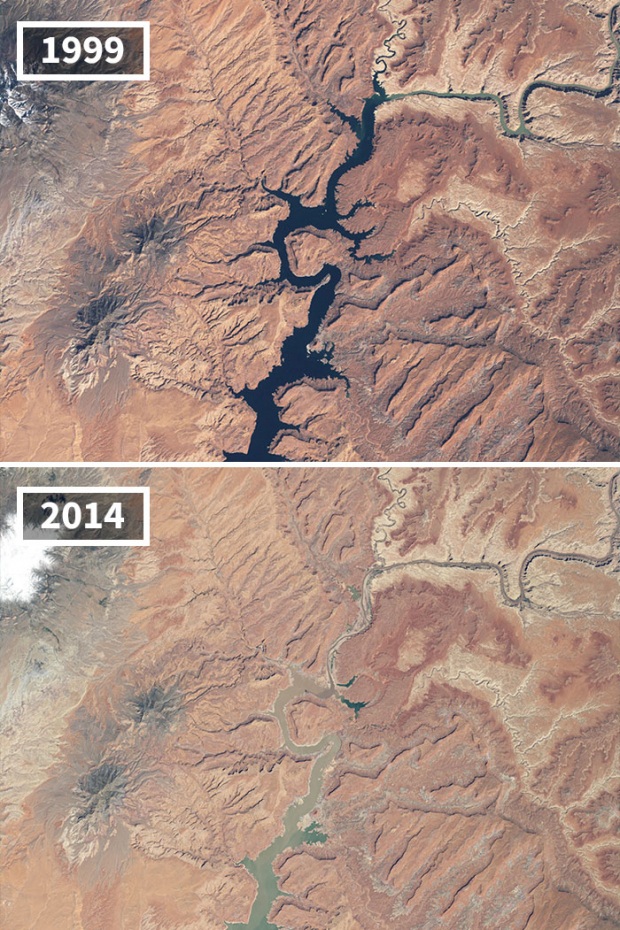
The unbelievable drought in Lake Powell, Arizona, and Utah
“Extended period of drought along with water withdrawals have caused a radical drop in Lake Powell’s water level. These pictures show the northern section of the lake, which is, in fact, a deep, narrow, zigzagging reservoir that extends from Arizona upstream into southern Utah. The 1999 picture shows water levels at almost full capacity. Around May 2014, however, the lake had dropped to 42 percent of capacity.”
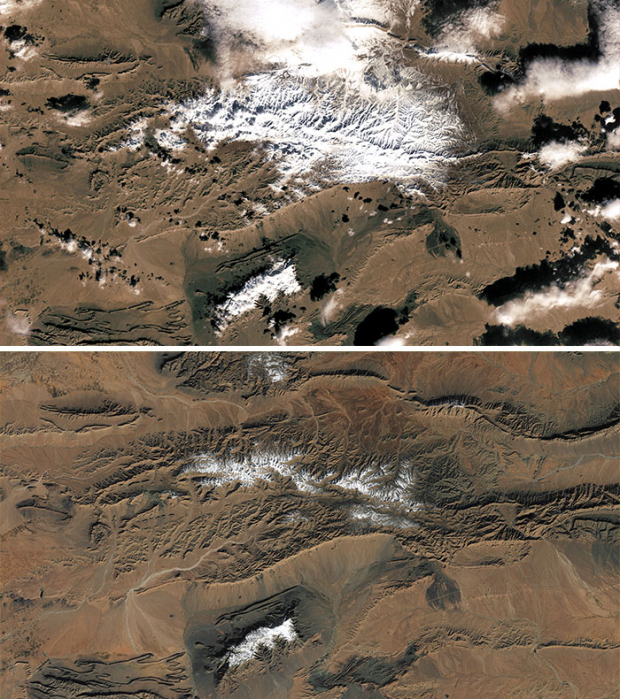
Uncommon snowfalls at the edge of the Sahara Desert
“Snow fell on the edge of northwest Africa’s Sahara Desert in mid-December 2016, which is not something that happens a lot in that area. The Landsat 7 satellite’s Enhanced Thematic Mapper Plus (ETM+) sensor managed to take the left picture of white over a caramel-colored landscape southwest of the Algerian tribe Ain Sefra, a town commonly known as the gateway to the desert. All of the snow vanished except at the highest elevations, as seen in the right picture captured by Landsat 8. The last time it snowed in Ain Sefra was in February 1979.”
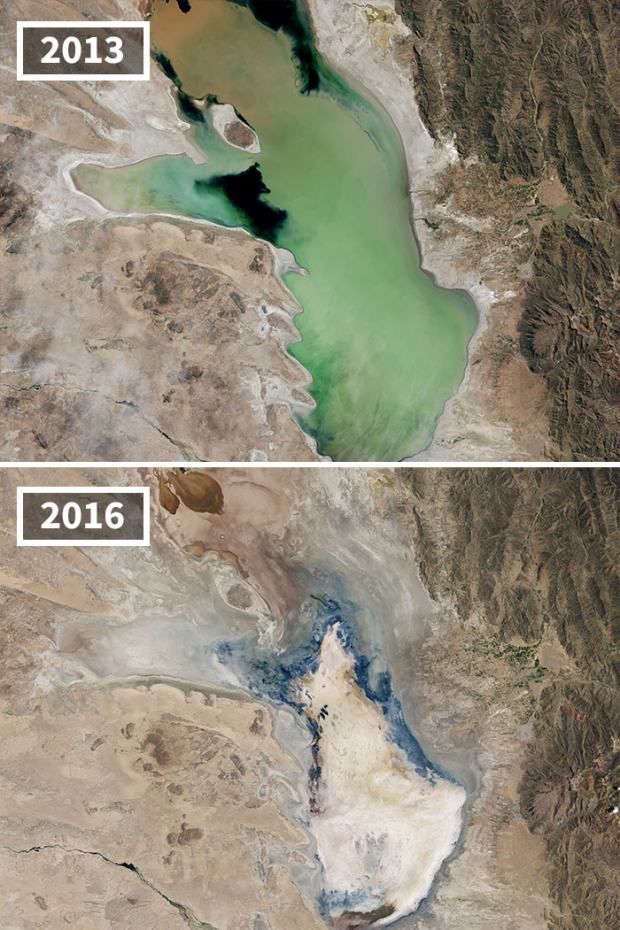
The horrible situation of Lake Poopo, Bolivia
“Lake Poopo, Bolivia’s second-biggest lake and a significant fishing resource for local communities, has dried up once again due to drought and diversion of water sources for mining and agriculture. It got dried in 1994 the last time, after which it took a couple of years for water to return and even longer for ecosystems to recover. During wet times, the lake has spanned an area of nearly 1,200 square miles (3,000 square kilometers). Its shallow depth- usually no more than 9 feet (3 meters)- makes it especially vulnerable to fluctuations,”
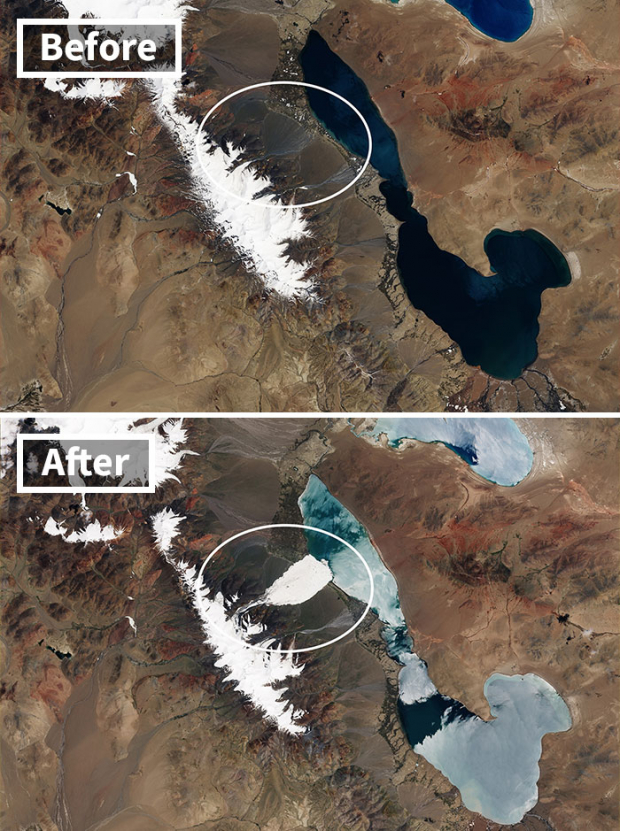
These photos of the ice avalanche in Tibet’s Aru Range
“The collapse of a glacier tongue on July 17, 2016, sent a giant stream of ice and rock crumbling down a narrow valley in Tibet’s Aru Range. Nine people living in the isolated village of Dungru were killed together with the herds of their 350 sheep and 110 yaks. The ice avalanche, one of the biggest ever recorded, left debris that was around 98 feet (30 meters) thick across 4 square miles (10 square kilometers). Glaciologists still haven’t figured out why this collapse happened.”
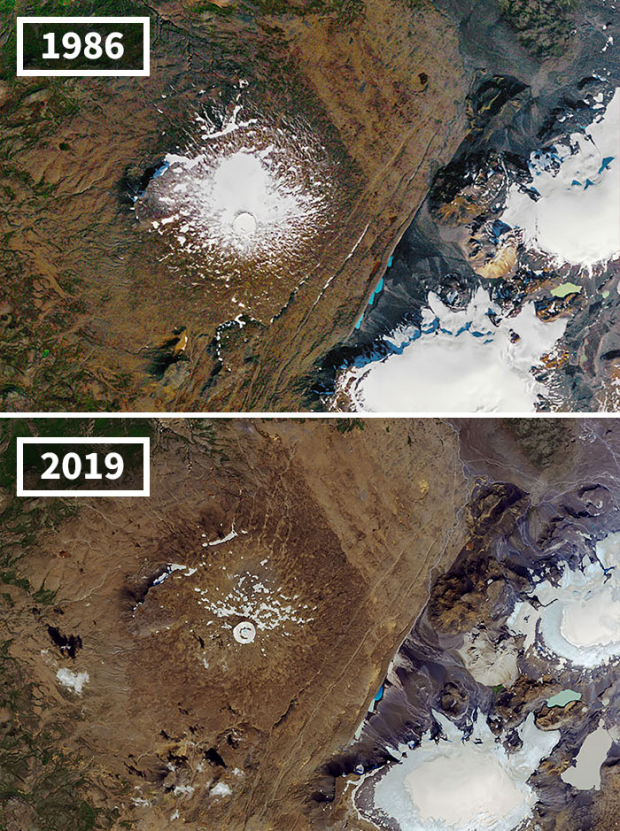
Iceland lost its Ok Glacier
“These pictures show the final stages of the decline of Okjokull, a melting glacier on top of Ok volcano in west-central Iceland. (“Jökull” means “glacier” in Icelandic) According to a 1901 geological map, Okjökull spanned around 15 square miles (38 square kilometers). In 1978, aerial photographs of the place showed the glacier had shrunk to approximately 1 square mile (3 square kilometers). Now, though only less than half a square mile (less than 1 square kilometer) of the glacier remains.”
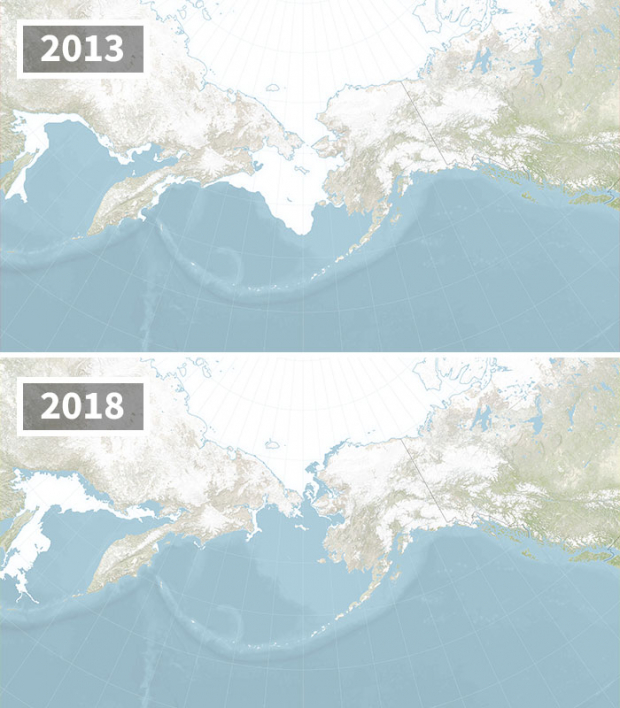
The drastic change in Bering Sea Ice
“Less ice formed in the Bering Sea during the winter of 2017-18 compared to any other winter season since the start of written records back in 1850. Typically, ice covers more than 193,000 square miles (500,000 square kilometers) of the sea towards the end of April, approximately twice the size of Texas. The ice extent during that time in 2018 was only around 10 percent of normal. Changes in when and where the sea ice melts may have an impact on phytoplankton blooms which, in turn, can affect the whole Bering ecosystem. Moreover, open water absorbs more of the Sun’s energy compared to ice, which contributes to the planet’s warming.”
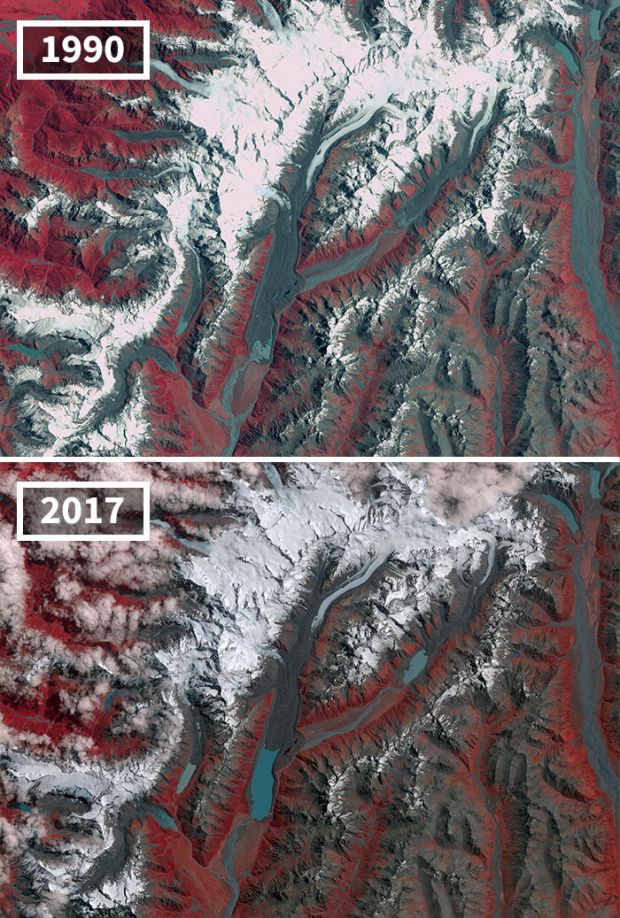
New Zealand is also on the verge of losing its glaciers
“New Zealand has more than 3,000 glaciers, most of which can be found on the South Island’s Southern Alps. The glaciers have been shrinking since 1890, with short periods of tiny advances. In 2007, experts at the country’s National Institute of Water and Atmospheric Research (NIWA) attributed this change mostly to global warming. Without fundamental climate cooling, they added, the glaciers would not return to their previous sizes. The differences between 1990 and 2017 can be clearly seen in these comparison photos, which include the Mueller Glacier, Hooker Glacier, and Tasman Glacier, New Zealand’s longest.”
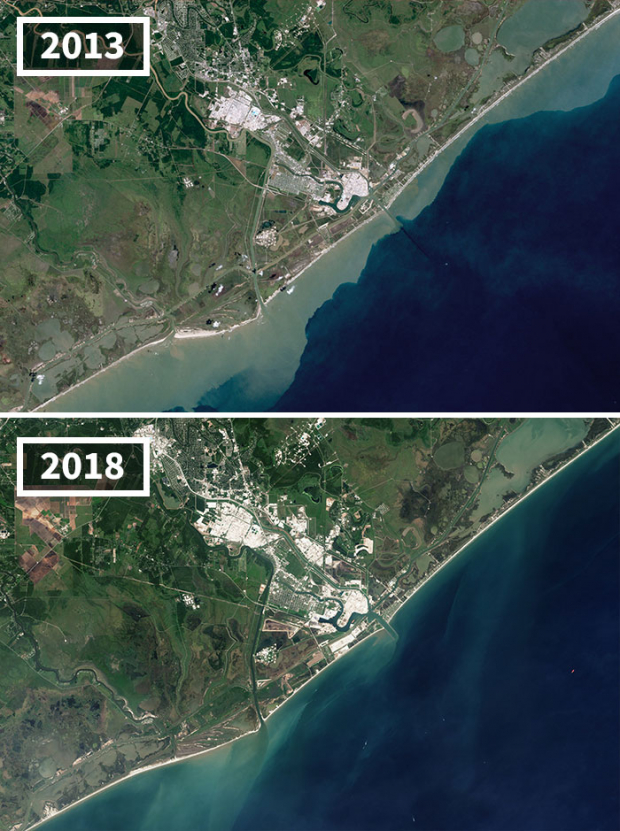
Beach erosion close to Freeport, Texas
“These pictures show an area a little bit south of Freeport, Texas where the beach is being lost at a rate of almost 49 feet (15 meters) every year along an 11-mile (17-kilometer) stretch. It’s one of the biggest erosive hotspots on the entire planet. A group of researchers from the Netherlands used Landsat satellite data to track changes in sandy beaches all over the world from 1984 to 2016. They came to the conclusion that 24 percent of the beaches eroded more than 20 inches (0.5 meters) every year, including over one-third of those classified as protected. Around 28 percent of sandy beaches grew and 48 remained as they were.”
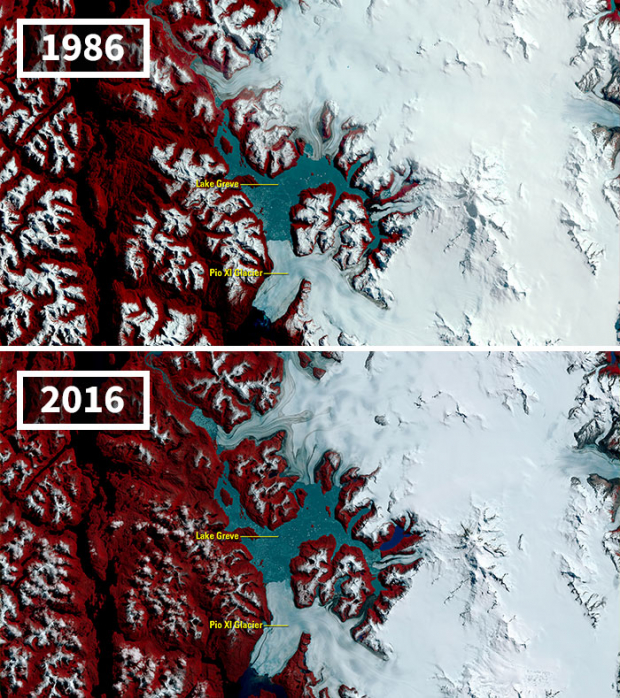
As glaciers melt away worldwide, one defies trend
“A lot of the world’s glaciers are shrinking and receding, such as those in Chile’s Southern Patagonia Icefield (SPI). But, one of the glaciers there, the Brüggen Glacier (also known as the Pio XI Glacier), is advancing even though no one knows why. Between the years 1998 and 2014, the glacier’s southern front advanced 593 meters (approximately 1,945 feet), and its northern front, which flows into Lake Greve, advanced 107 meters (roughly 351 feet). According to scientists, that activity inside or beneath the glacier could be making it advance, together with other elements such as flow speed and the lake’s depth. Even though we still don’t know the exact cause, the SPI glaciers continue to be closely monitored from space.”
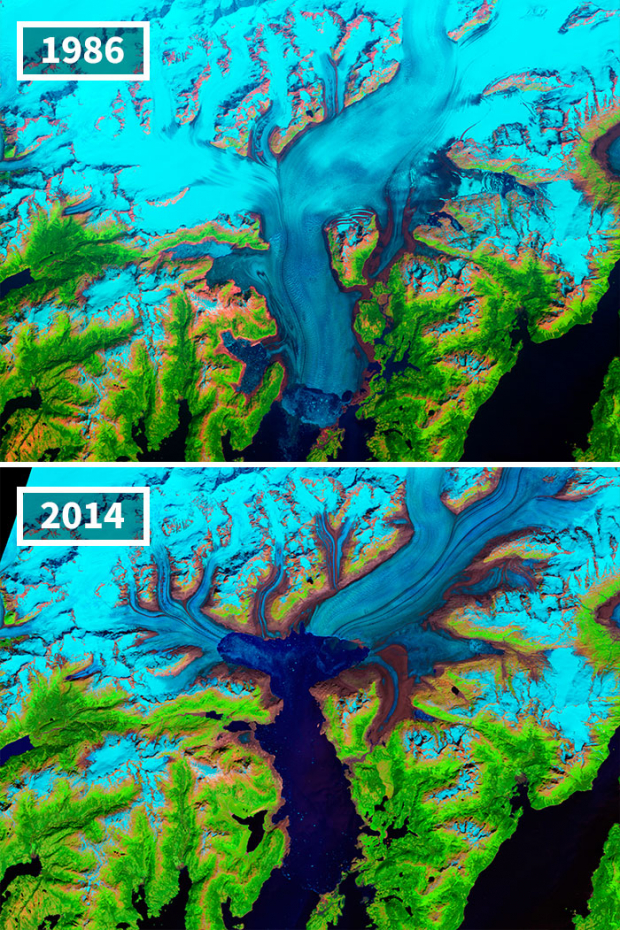
Alaska’s Columbia Glacier is melting away
Columbia Glacier in Alaska goes down through the Chugach Mountains into Prince William Sound. When British explorers examined the glacier in 1794, its nose extended to the northern edge of Heather Island, close to the mouth of Columbia Bay. The glacier held that position until 1980, and in that year, it started to shrink rapidly. The glacier has melted so much that the up and down motion of the tides affects its flow approximately 12 kilometers (7.5 miles) upstream until the glacier bed rises above sea level and the ice loses contact with the ocean.”
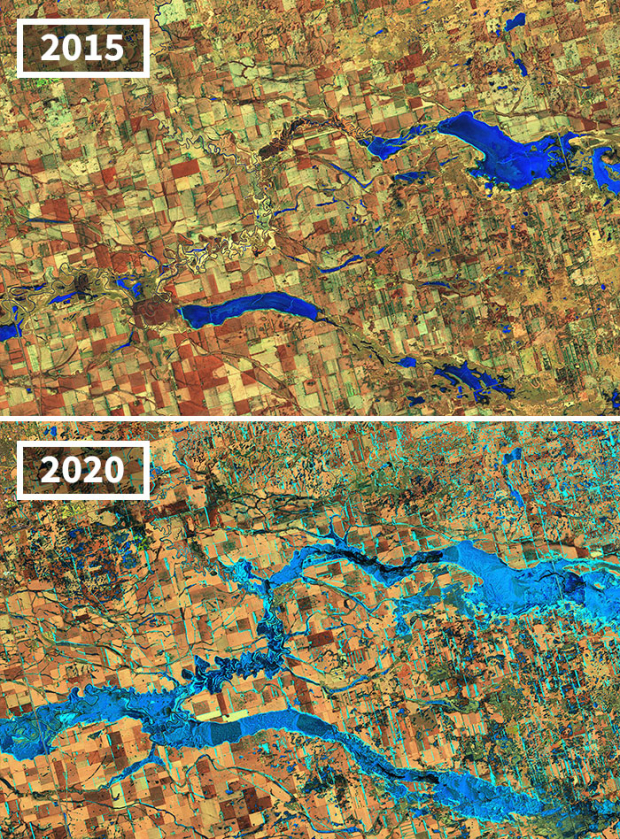
These photos of the flood of the James River in South Dakota
“These photos show a section of the James River in South Dakota. The 2015 photo shows the river in a usual spring, whereas, in the 2020 photo, it is overflowing its banks. This and other parts of the river had been at flood level since spring 2019. In these false-color photos, ice is colored light blue and water is dark blue. The blue part merging with the river from below is Putney Slough, which also flooded.”
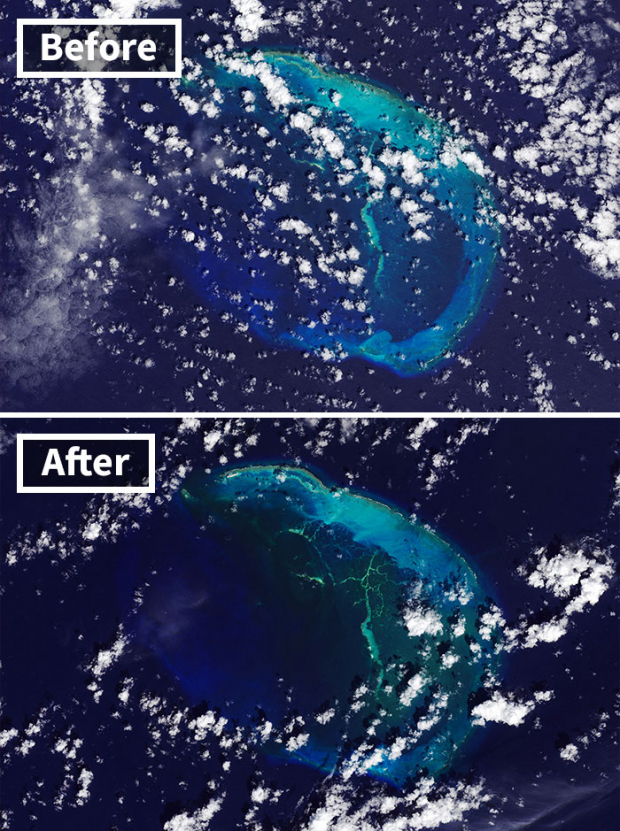
Hawaiian Island is no more
“Until Hurricane Walaka struck in October 2018, East Island, which can be seen in the September picture, was a part of the Northwestern Hawaiian Islands. However, the storm washed away a big part of the 11 acres of sand and gravel that constituted the island, leaving just two slivers of land, visible in the October picture. East Island was included in the French Frigate Shoals, a reef in the Papahanaumokuakea Marine National Monument.”
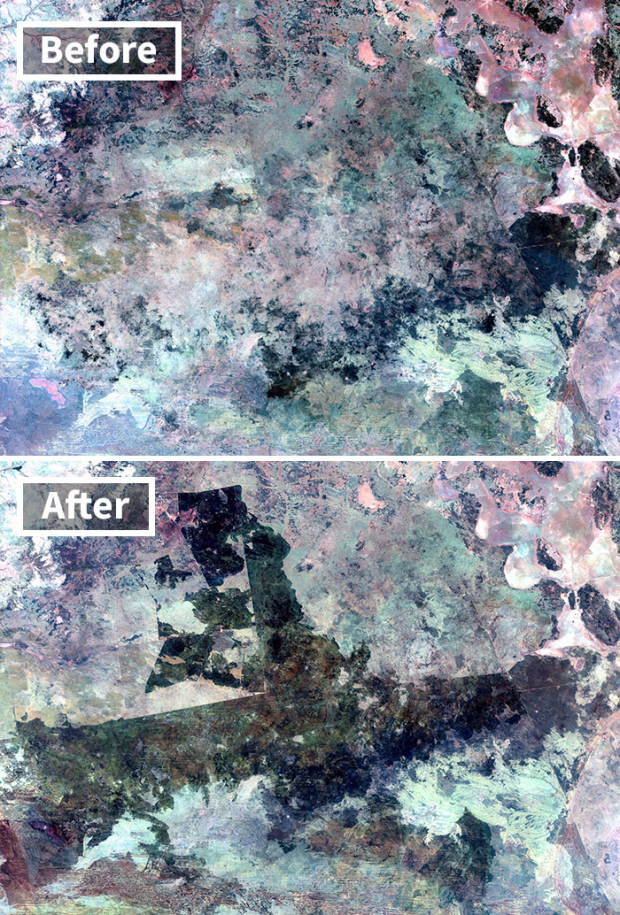
The horrible fires in the Australian Tanami Desert
“Terribly dry conditions have led to big fires in north-central Australia during the past year. In February, fires along the coast caused a lot of damage, and lots of animals also died. Not so long ago, dry conditions fed a lot of fires in Australia’s least populated area, the Tanami desert region, which is approximately the size of Texas and Iowa combined. Vegetation on its sand ridges and plains is mostly just short grasses and shrubs. The September 7 satellite picture depicts scars (dark area) from previous fires. When you take a look at the September 23 picture, you see the scarring is getting bigger due to active fires.”
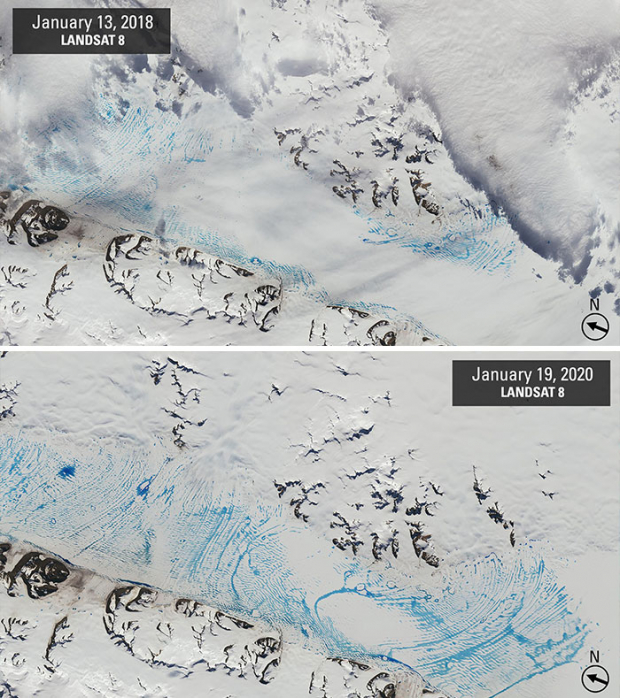
These comparison pictures of meltwater on George VI Ice Shelf, Antarctica
“Even in very cold Antarctica, depressions on the surface of a glacier can fill with meltwater during the comparative warmth of summer. The blue parts in the 2020 photo show the most widespread meltwater pooling- extending around 90 miles (140 kilometers)- ever recorded on the George VI Ice Shelf. This giant slab of glacier ice sticks out from the western side of the Antarctic peninsula and floats on the waters separating the peninsula from Alexander Island. Pools like these can weaken ice shelves, but George VI is thought to be strong enough to withstand them.”
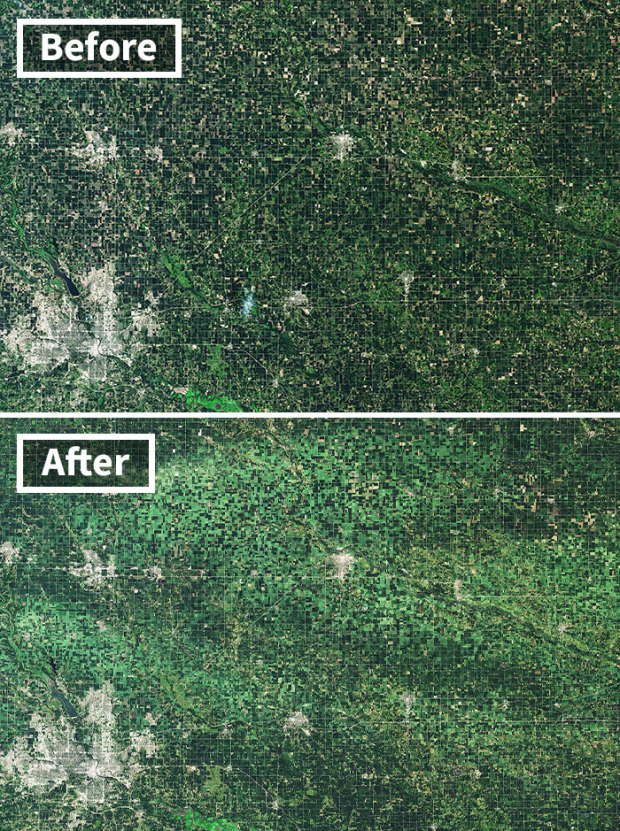
A powerful windstorm flattens Iowa crops
“This powerful windstorm also called a derecho, tore across Iowa, northern Illinois, and northern Indiana on Aug. 10, 2020, with hurricane-forced winds of 75 mph (120 kph) or more. Eastern Iowa faced winds of up to 115 mph (185 kph) or so reported the National Weather Service. These photos show the fields of corn and soybeans in that state, before and after the windstorm. The lighter green parts in the August photo show crops that the winds damaged.”
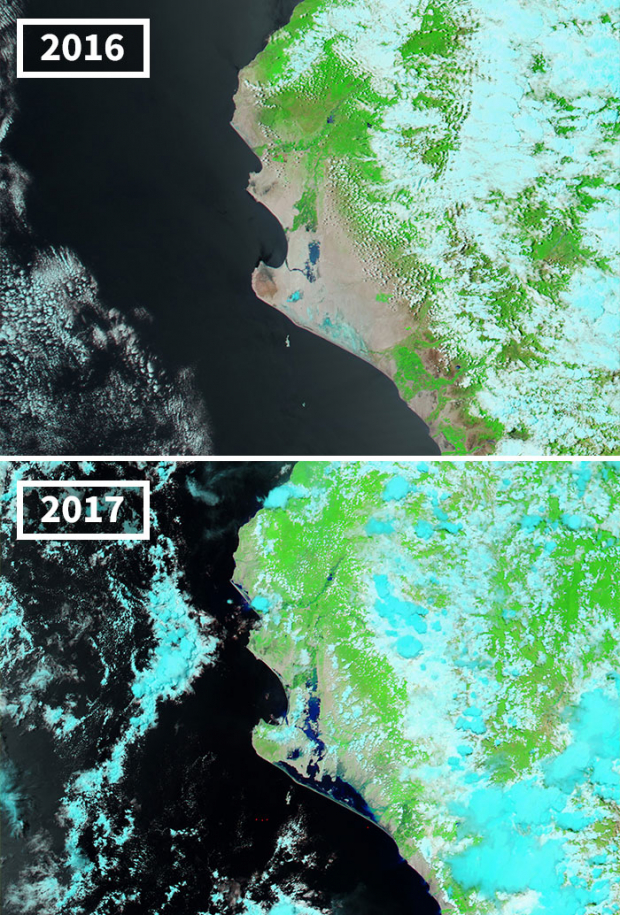
Peru is flooded because of heavy rains
“Heavy rains that began in mid-March 2017 have damaged Peru for the most part. Reports stated that more than 70,000 people lost their homes and over 60 people lost their lives in mudslides and floods. Both the Lago La Nina and Piura River ended up overflowing their banks. According to the official data, approximately 4,660 miles (7,500 km) of roads and 509 bridges have been damaged. In these false-color photographs, clouds and salt pans (depressions in the ground in which saltwater evaporates, leaving the salt behind) can be seen in light blue color.”
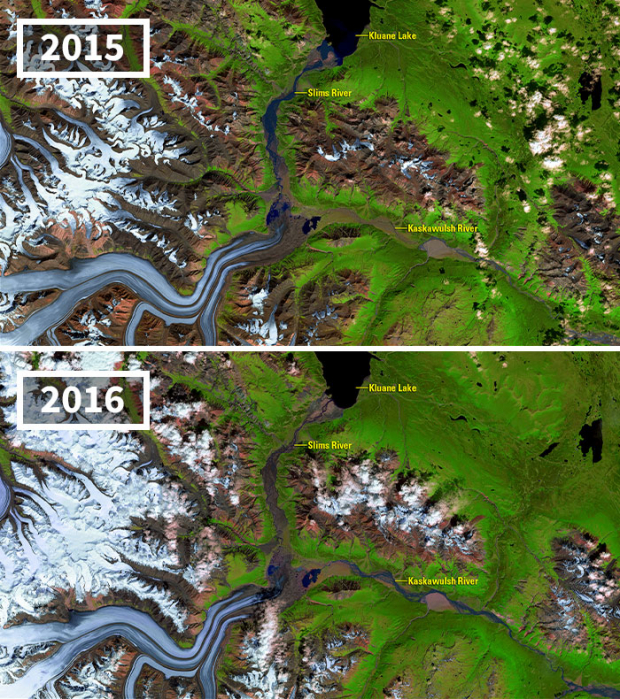
Kaskawulsh Glacier meltwater possibly alters downstream ecosystems permanently
“Similar to most other glaciers around the world, Kaskawulsh Glacier in the Kluane National Park and Reserve of southwestern Yukon Region, Canada, has receded over the past couple of decades. A Nature Geoscience article also states that this receding glacier caused an uncommon instance of river piracy-the diversion of one stream’s headwaters into another. Rather than flowing north via the Slims River into Kluane Lake, finally reaching the Yukon River and the Bering Sea as it did before the spring of 2016, a lot of the meltwater now flows eastward to the Alsek River and the Pacific Ocean via the Kaskawulsh River. This diversion caused sediment changes, mixed timing of flows from the glacier and water level changes to the channels, probably permanently altering downstream ecosystems.”

